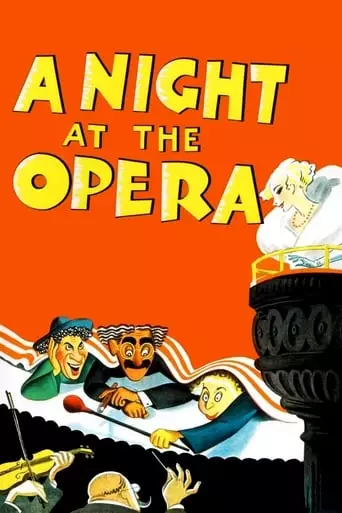
A Night at the Opera (1935) Watch Online Free
The Marx Brothers take on high society and the opera world to bring two lovers together. A sly business manager and two wacky friends of two opera singers help them achieve success while humiliating their stuffy and snobbish enemies.
A Night at the Opera is a 1935 American comedy film featuring the Marx Brothers—Groucho, Harpo, and Chico—in their first collaboration with Metro-Goldwyn-Mayer (MGM). Directed by Sam Wood, the film is renowned for its blend of slapstick humor, musical performances, and a satirical narrative that critiques the opera world and high society.
The story revolves around the efforts of Otis B. Driftwood (Groucho), a scheming opera manager, to promote the careers of two talented but overlooked singers: Rosa Castaldi (Kitty Carlisle) and Ricardo Baroni (Allan Jones). Driftwood’s plan involves casting them in a prestigious opera production, despite the interference of the opera’s wealthy patron, Mrs. Gloria Teasdale (Margaret Dumont), and the opera’s temperamental star, Signor Lassparri (Walter Woolf King). The Marx Brothers’ antics ensue as they navigate the absurdities of the opera world, culminating in a chaotic and humorous performance.
The film’s narrative structure is a departure from the brothers’ earlier, more anarchic films, incorporating a more coherent plot with musical interludes. This shift was influenced by MGM’s desire to appeal to a broader audience and to integrate the Marx Brothers’ humor into a more traditional cinematic framework. Despite these changes, the film retains the brothers’ signature comedic style, characterized by rapid-fire dialogue, visual gags, and satirical commentary on societal norms.
The film satirizes the pretensions and absurdities of the opera world and high society. Through characters like Mrs. Teasdale and Signor Lassparri, it exposes the superficiality and elitism of the upper class, highlighting the contrast between their lofty self-image and the Marx Brothers’ irreverent humor.
Despite its comedic tone, the film underscores the transformative power of music and art. The opera serves as a backdrop for the characters’ personal growth and connections, illustrating how art can bridge social divides and bring people together.
The narrative explores themes of class and social hierarchy, particularly through the characters’ interactions with Mrs. Teasdale and the opera’s elite patrons. The Marx Brothers’ characters, coming from humble backgrounds, challenge and disrupt the established social order, highlighting the absurdity of class distinctions.
The film juxtaposes the idealistic notions of romance and success with the reality of the characters’ situations. The romantic subplot between Rosa and Ricardo is complicated by their differing social statuses and the interference of the opera’s hierarchy, reflecting the challenges of achieving one’s dreams in a structured society.
Upon its release, A Night at the Opera was both a critical and commercial success, revitalizing the Marx Brothers’ film career and introducing their unique brand of humor to a wider audience. The film’s innovative blend of slapstick comedy with musical and romantic elements set a new standard for comedy films, influencing the genre for years to come. Its success demonstrated that the Marx Brothers could adapt their anarchic style to a more structured narrative without losing their comedic essence.
After watching A Night at the Opera, you will likely feel a sense of joy and satisfaction from the film’s delightful blend of humor, music, and social satire. The film’s iconic comedic sequences, particularly the stateroom scene, will leave you laughing out loud, while the sharp wit and absurd antics of the Marx Brothers will keep you entertained throughout.
The way the film critiques the opera world and high society may also leave you reflecting on the contrast between the pretensions of the elite and the anarchic, yet heartwarming, humor of the brothers. You may find yourself appreciating the film’s clever commentary on social class, art, and the illusions of romance, while also marveling at how it skillfully blends farcical comedy with genuine emotion.
The musical performances, especially the opera sequences, will likely add a layer of sophistication to your viewing experience, giving you a deeper appreciation for how the film merges the world of high culture with slapstick comedy. The romantic subplot, though secondary to the brothers’ antics, will evoke a sense of nostalgia for classic cinematic love stories, offering a nice balance to the humor.
Ultimately, after watching A Night at the Opera, you will feel entertained, amused, and perhaps even inspired by the timeless brilliance of the Marx Brothers. Their ability to deliver laughs while subtly critiquing societal norms is what makes this film a classic, and you will likely appreciate the enduring impact it has had on both comedy and cinema as a whole.
